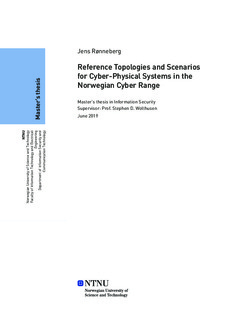| dc.contributor.advisor | Wolthusen, Stephen D. | |
| dc.contributor.advisor | Gkioulos, Vasileios | |
| dc.contributor.author | Rønneberg, Jens | |
| dc.date.accessioned | 2019-09-19T14:01:05Z | |
| dc.date.available | 2019-09-19T14:01:05Z | |
| dc.date.issued | 2019 | |
| dc.identifier.uri | http://hdl.handle.net/11250/2617757 | |
| dc.description.abstract | «Cyber-physical systems» (CPS) er systemer som er konstruerte av cyber- og fysiske komponenter, og som samhandler med mulig hjelp av menneskelig interaksjon. CPS brukes i kritiske infrastruktursektorer som energisystemer og helsevesenet, men også andre områder som industri, smarte byer og smart hjem-automatisering. Disse systemene er allerede utsatt for angrep. Hovedmålet med denne oppgaven er å modellere og simulere CPS-topologier for et energisystem og et smart hjem-automatiseringssystem. I oppgaven blir en forståelse av en "normal driftstilstand" for de to systemene etablert, og de grunnleggende arkitektoniske egenskapene og kommunikasjonsprotokollene blir identifisert. De opprettede topologiene er blitt oversatt til nettverkssimuleringsmiljøer ved hjelp av et simuleringsverktøy kalt OMNeT++, og mock kontroll og informasjonsflyt er utformet for å fange master/slave-hierarkiene. Begge de simulerte systemene har vært testobjekter for to utvalgte sett med nettverksangrepsscenarioer, spesielt rettet mot sanntids-ytelseskarakteristikk. Angrepsscenarioene er basert på TCP- og UDP-flomangrep, og deres innvirkning på systemet blir evaluert. PMUer i smart grid-systemet, overvåkningskameraet og gatewayen i det smarte hjemmesystemet viste en økning i ende-til-ende-forsinkelsen og jitter under angrepene. Dette førte til en tidsforsinkelse på systemene, men effekten var mindre problematisk og påvirket ikke den generelle tilstanden. | |
| dc.description.abstract | Cyber-physical systems (CPS) are engineered systems of cyber and physical components that interact with the possible help of human interaction. CPS is being used in critical infrastructure sectors such as energy systems and health care, but also other areas such as manufacturing, smart cities, and smart home automation. These systems are already subjected to attacks. The primary objective of this thesis was to model and simulate CPS topology for an energy system and a smart home automation system. An understanding of a "normal operation condition" of the two systems has been established, as well as identifying the fundamental architectural characteristics and communication protocols. The created topologies have been translated into network simulation environments using a simulation tool called OMNeT++, and mock control and information flows have been designed to capture the master/slave hierarchies. Both of the simulated systems have then been the test subjects for two selected sets of network attack scenarios, particularly targeting real-time performance characteristic. The attack scenarios are based on TCP and UDP flood attacks, and their impact on the system was evaluated. PMUs in the smart grid system and the surveillance camera and the gateway in the smart home system showed an increase in the end-to-end delay and jitter during the attacks. This caused a temporal delay on the systems and the impact was minor issues and do not affect the overall state. | |
| dc.language | eng | |
| dc.publisher | NTNU | |
| dc.title | Reference Topologies and Scenarios for Cyber-Physical Systems in the Norwegian Cyber Range | |
| dc.type | Master thesis | |
